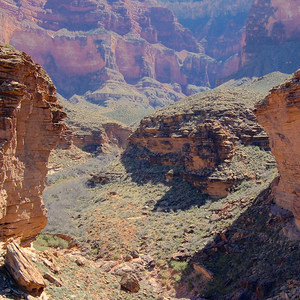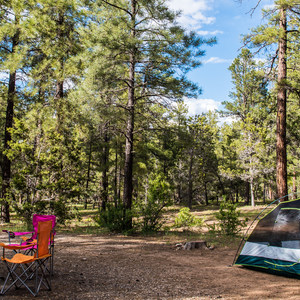You are here
The Hermit Trail is one of the Grand Canyon classics, though it is much less traveled than the popular Bright Angel or South Kaibab Trails. This corridor to the Colorado River offers vantages of the western part of the park that you won't get from the other South Rim trails, and a major plus is that Hermit is free from mules and waste. Expect a more rugged journey here, however. Because the trail is not maintained, erosion has left parts of the trail rocky or partially washed out.
But it was not always this way. The Hermit Trail was one of the original routes to the bottom of the Grand Canyon, and a lodge thrived at Hermit Creek a decade before Phantom Ranch was built. From 1911 until 1930 when the camp ceased operations, Hermit Trail was the primary means of access to the lodge, though an aerial tramway was engineered to deliver guests in luxury. The tramway and buildings have long since been dismantled, and old cobbles on Hermit Trail were intentionally removed to return the area to a wilder state. Keep an eye out for relics of this Grand Canyon history. You can still find well-worn stones on the pathway and evidence of century-old development near Hermit Creek.
This trail is also testament to the geologic history of the canyon and landscapes that existed eons before the first human travelers. Just below the rim, notice the limestone fossil beds of seashells and sponges that inhabited a shallow sea. Further down the switchbacks, look carefully for the frozen footprints in Coconino sandstone. These are tracks of primitive reptiles that scurried across prehistoric sand dunes. You can tell by the tracks which ones were climbing up the sandy slope and which ones were sliding down, which ones dragged their tails and which ones did not. As you descend further into the canyon you'll travel through more geologic legacies: a river delta, a rising and receding ocean, a coastal plain, and volcanic eruptions. Try to imagine the environmental phases that have continually formed this timeless place.
Logistics
Like any trail in the Grand Canyon, Hermit Creek is a serious desert hiking endeavor. Remember that temperatures climb as you descend, and water is precious. Between Santa Maria Spring and the creeks near the river, there are no water sources. Be prepared with all the water, calories, and endurance necessary for your trip.
Hermit Trail is accessed from Hermit Road, which is closed to most traffic during the high season. To get to the trail as a day hiker you will have to ride the free shuttle from Grand Canyon Village. If you have a backcountry camping permit, you will also receive a gate code and a parking pass so you can drive the road in your own vehicle and leave it parked at the trailhead for the duration of your trip.
Mileages
Trailhead to Hermit Creek Camp: 8.2 miles
- Trailhead to Santa Maria Spring: 2.2 miles
- Santa Maria Spring to Breezy Point: 3.3 miles
- Breezy Point to Tonto Trail Junction: 1.5 miles
- Tonto Trail Junction to Hermit Creek Camp: 1.2 miles
Trailhead to Colorado River at Hermit Rapid: 9.7 miles
- Hermit Creek to Colorado River at Hermit Rapid: 1.5 miles
Trailhead to Monument Creek Camp: 9.3 miles
- Tonto Trail Junction to Monument Creek Camp: 2.3 miles
Trailhead to Colorado River at Granite Rapid: 10.3 miles
- Monument Creek to Colorado River at Granite Rapid: 1.6 miles










Comments
While camping on the beach, the weather was clear, so I decided to not put the fly up over my tent. About 10:30 at night I woke up to fairly high gusts of wind which was blowing the fine sand through the mesh into my tent (Big Agnes Fly Creek UL1). I covered my head with my shirt and went back to sleep. When I woke up in the morning there was a layer of sand coating everything. My daughter put her fly up when the wind picked up, but she had a thin layer of sand in her tent too. The sand was lifted up under the fly and into the tent.
The weather in the canyon was warm . My Marmot NanoWave 55 Sleeping bag was comfortable and kept the blowing sand off of my body.
The water in Hermit Creek was clear and cool. We refilled our water bottles twice from hermit Creek, Sunday afternoon and Monday morning (using Sawyer water filter), and again on the hike out at Santa Maria Spring.
Sign In and share them.